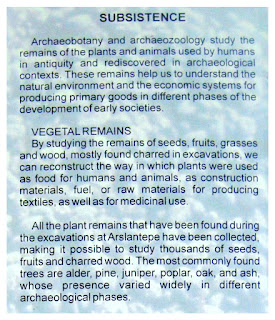Photos by Jack A. Waldron
Finally, after almost three years of living and teaching in Malatya, I made my way to the Malatya Archeological Museum (38°20'34.5"N 38°19'28.2"E). Visiting museums when you arrive in a new territory or city should actually be a first priority, because you will gain a lot of information on the sites located in the surrounding and extended area.
Pictured below, tiny idols that were easily lost by their owners within the mud brick dwelling dated to the Late Chalcolithic Periods.
During the Late Chalcolithic Periods, stone, bone and animal horn were the primary materials used for the production of a wide variety of items, and when considering the items produced, other than a refinement of these items, not much has really changed when compared to today. Such items consist of needles, operating tools, axes, knife blades, weights, ornaments, and on, and on, and on.
Though our ceramic coffee and tea cups today are mass produced in large factories with an endless variety of shapes, sizes and colors, the ceramic cups produced 6000 years ago served the same purpose, minus the cleaver quip, slogan or picture.
While living in Japan, I used bowls such as those pictured below on a daily basis. Pottery such as this can be found in most Asian homes. In Turkey and the Middle East, clay baking pots and bowls are used daily to produce a variety of oven stews.
Notice the small symbol on the right side of the large pot pictured below, that can also be seen on the walls of the storage rooms of the Palace Complex discussed in Aslantepe Part 3, and which are thought to be a priest with arms raised to the gods in a ceremonial depiction.
Unfortunately, the ongoing quest for water sources in Eastern Turkey have taken a great toll on numerous archeological sites, and Cafer Hoyuk, which was located 40 km northeast of Malatya, is one of the victims.
Illustrated below, we can see that the dammed Euphrates has filled the lower valleys, where several ancient sites have been flooded.
The ceramic idols and pottery pictured below are some of the items found during the rescue excavations carried out between 1986-1988.
An idol most likely, to child a toy maybe, like the figures in a nativity scene, but can't know for certain of the representations in painting or sculpture from Chalcolithic period, as no written explanations have been unearthed.
Pictured below, a simple earthen burial, which has been painstakingly rescued from the site. These mud structures do not last long after being exposed to the elements.
Seal stamps used for the accounting, security, and recording of goods in their amounts, safety, ownership, and so on. The move from pictorial recognition to pictorial writing seems like an obvious transformation.
Pictured below, a very heavy strainer!! My mind wanders to plastic and metal utensils we use today, and when compared to their related forms during the Chalcolithic period, form and utility really hasn't changed so much.
*All photos and content property of Jack A. Waldron (photos may not be used without written permission)
**Please support my work and future postings through PATREON:
Or, make a Donation through PayPal:




















































No comments:
Post a Comment
Note: Only a member of this blog may post a comment.